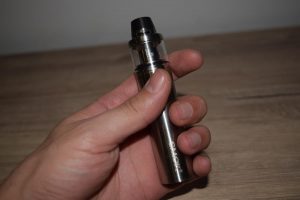Study on the Formation of Benzene in E-Cigarettes Finds More of It in Ambient Air
The authors of a new study on the formation of benzene in electronic cigarettes struggle to suggest that levels of the known carcinogen detected during their research can be considered dangerous, when in reality they are much lower than the benzene found in tobacco smoke and even ambient air.
 Let me just start by saying that if you want to know how misinformation about e-cigarettes works, this study is a perfect example. Even though the results of the research are pretty obvious, the authors try their best to paint a different, more ominous picture, both in the study itself and in the press release promoted primarily by medical news sites. It’s quite a piece of work, and if not for the thorough explanation of objective scientists like Dr. Konstantinos Farsalinos, most of us would have probably fallen for these lies.
Let me just start by saying that if you want to know how misinformation about e-cigarettes works, this study is a perfect example. Even though the results of the research are pretty obvious, the authors try their best to paint a different, more ominous picture, both in the study itself and in the press release promoted primarily by medical news sites. It’s quite a piece of work, and if not for the thorough explanation of objective scientists like Dr. Konstantinos Farsalinos, most of us would have probably fallen for these lies.
Anyway, the study “Benzene Formation in Electronic Cigarettes“, published in the PLOS One scientific journal, set out to investigate the levels of the dangerous carcinogen in three different types of e-cigarettes – the PAX JUUL, and a couple of variable wattage batteries paired with the Kanger EVOD (1.8Ω coil) and Subtank nano (1.2Ω coil) atomizers. In his analysis of the study, Dr. Farsalinos points out that the research was carried out based on the finding that JUUL e-liquid contains high levels of benzoic acid (45 mg/ml or 4.5%) , due to its proprietary nicotine salts (nicotine complexed with organic acid). And since benzoic acid could degrade into benzene, the chances of finding considerable amounts of it in e-cigs was considerable, or so the researchers suspected. However, the high levels of benzoic acid are unique to the JUUL. As the study authors themselves point out, other commercial e-liquids they tested had a benzoic acid content of 0.02-2 mg/ml (0.002-0.2%).
Here’s where things get interesting. Testing for benzene in the vapor produced by the PAX JUUL, the levels turned out NON-DETECABLE, so the chances of actually finding any benzene in vaporized commercial e-liquid, with much lower levels of bezoic acid, were pretty slim. So instead of using those, they made their own custom e-liquids, with 9 mg/ml benzoic acid, 10 mg/mL benzaldehyde (a chemical flavoring) and nicotine.
But the researchers were just getting started. When it came to actually testing for benzene using the variable wattage devices, they once again proved that they lack a basic understanding of vaping and concepts like “dry puff”. The EVOD tank with a 1.8 ohm resistance coil was stressed at 13W, despite the researchers themselves mentioning that the recommended setting for the tank was 6W. The Subtank (1.2-ohm coil) was tested at 25W, which may be within the recommended power setting but definitely not for for 5-second puffs, the puff duration set for both devices. Anyone who has ever used either of these two atomizers – both of which can be considered obsolete nowadays – knows that 5 seconds is way too much, especially at these settings, and will most likely result in disgusting dry puffs. So much for real life testing conditions…
But even though no one could actually vape under the conditions detailed in this study, the results are still very interesting. As I mentioned in the beginning, for the JUUL, testes yielded non-detectable levels of benzene in the vapor. For the Kanger EVOD atomizer, at the recommended 6W power setting, benzene levels ranged from non-detected (in most samples), to 0.16 μg/g, while at 13W (dry puff conditions) researchers found up to 24 μg/g of benzene. With the Subtank nano, results ranged from non detected to 0.19 μg/g at the highest power settings.
The study authors calculated the concentration of benzene in inhaled air, and reported levels up to 5000 μg/m3 air (in dry puff conditions), which compared to the ambient air levels of 1 μg/m3 of benzene make these results seem catastrophic for vaping. Luckily, Dr. Farsalinos does a great job of explaining what they really mean:
“This methodology suffers from a major problem,” the Greek scientist writes on his blog. “Humans take about 12 breaths per minute, i.e. 17,000 (thousand) breaths per 24 h. The volume of air inhaled in 24 h is 20 m3. So, the daily exposure to benzene from ambient air is 20 μg. Even if you assume that Subtank at 25 W with 5-second puffs represent realistic conditions (they are not), you need to consume 105 mL e-liquid per day in order to be exposed to the same levels of benzene as breathing ambient air. For the EVOD under normal vaping conditions, you need to vape 125 mL e-liquid per day.”
Under these conditions, I don’t even know if it’s worth comparing the levels of benzene detected during this study to those found in tobacco cigarettes – 200,000 μg/m3. The difference speaks for itself.
But just because they couldn’t really find a problem with benzene levels in e-cigarette vapor during their testing doesn’t mean they can’t act like they did. The press release for the study claims that benzene levels in one of the tested devices “were thousands of times higher than in ambient air”.
James F. Pankow, chemistry professor at Portland State University and lead author of the study, said: “The fact that vaping can deliver benzene levels many times higher than those found in the ambient atmosphere – where it’s already recognized as a cancer risk – should be of concern to anyone using e-cigarettes. Please, stay away from high power if it’s available on your device”
How about you stop ignoring the dry puff phenomenon in your studies before giving advice on something you clearly don’t understand? I’m pretty sure that vaping at 100W with an appropriately low resistance coil is much safer than literally burning the cotton wick, as you did in this study. But hey, I guess scaring people with values like 150W, 200W is easier than actually proving that vaping actually produces high levels of benzene.
As Dr. Farsalinos’ analysis of this study concludes, “benzene formation in e-cigarettes: it does not exist…”

















thank you for writing this article and helping to stop america from the great vape scare! phony scientists these days with their phony vape studys